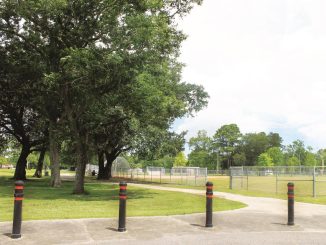
Past Times by Terry Jones
A year ago this month, a 1,000-year flood event devastated North Louisiana, only to be followed by a second one in South Louisiana five months later.
When videos of swimming deer found their way onto the internet, sportsmen began wondering what effect the floods would have on the herd.
It wasn’t the first time high water had threatened the state’s deer population.
One of the worst floods to hit Louisiana occurred in the spring of 1973. So much land went under water that an Oil City, Penn., newspaper claimed, “If the ocean had treetops sticking out of it, it would look like Catahoula Parish.”
Huge numbers of animals were displaced, and officials took the extraordinary step of broadcasting corn, oats, soybeans, and range pellets in the Atchafalaya Basin and along the Mississippi River to insure the stranded deer would survive.
In Arkansas, several hundred deer became trapped on Montgomery Island in the Mississippi River. It was believed that the island had the highest concentration of deer of any river island with an estimated two deer per acre.
When it was discovered that the deer had eaten all of the available forage, biologists landed on the island with chain saws and cut down trees and saplings to provide more browse.Mississippi seems to have had the most displaced wildlife during the 1973 flood. One Greenville newspaper columnist wrote, “Deer, turkey and other animals have been reported alongside Miss. Highway 1, both north and south of Greenville. If you are traveling on this road, watch out for the animals. . . . In spite of the high stage of the Mississippi River, many deer are still on the river side of the levee. Some have found high ground and are sticking it out. I have heard that in some cases, these deer are being fed by members of some hunting clubs.”
So many animals sought refuge along the Mississippi River levee that a special task force of agents was formed to protect them from poachers, dogs, and well-meaning citizens. C. B. McSwain, an official with the Mississippi Fish & Game Commission, stated, “We wanted to have a display of force for the poachers who might be headlighting or killing deer who are too weak after swimming a long distance to the levee.”
McSwain also warned the public that agents were shooting dogs found on the levee without collars so they would not kill the defenseless deer. “Dogs are molesting deer horribly,” he declared, although he was unable to give an estimate as to how many deer the canines had killed.
Another major problem Mississippi authorities had in 1973 was well-meaning citizens trying to revive exhausted deer found along the levee in Bolivar, Washington, and Issaquena counties.
“These deer swim for two miles, let’s say, and they get on the bank completely exhausted and unable to walk.” McSwain reported. “These people crowd around them and try to revive the deer. The deer are so shy and wary, they go into shock and could have a heart attack. Many times the deer jumps back into the water and drowns before the horrified eyes of the people who tried to save it.”
Despite the dramatic stories, officials did not expect the high water to have much of an impact on wildlife. “What is lost may not be more than what is taken out during a regular season,” McSwain reported. “It will be a limiting factor, but certainly not to the extent that it is a detrimental limiting factor.”
Authorities in both Louisiana and Mississippi were convinced that few deer actually starved during the 1973 flood. One Mississippi official theorized, “The deer that did die from starvation were probably already in bad shape or stress, and harassment played a part in it.”
This same official estimated that only about 500 out of approximately 5,000 deer that became stranded on the Mississippi River levee between Mayersville and Vicksburg died. He also stated that about 100 deer died of starvation in Louisiana in the Diamond Point area south of Vicksburg.Jaw bone studies revealed that approximately 90 percent of the deer that perished were about one year old. According to the state official, “[The] other deer in the same area were found to be in good shape.”
So when the next inevitable flood comes our way, we should look to the past and take comfort in knowing that Louisiana’s deer herd has been surviving such events for thousands of years.




Be the first to comment